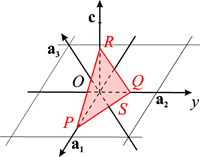Difference between revisions of "Bravais-Miller indices"
From Online Dictionary of Crystallography
(more precise and correct formulation) |
(switched reference from lattice system to crystal system.) |
||
| Line 4: | Line 4: | ||
== Definition == | == Definition == | ||
| − | + | For trigonal and hexagonal crystals, it is useful to use a reference built on four axes, three in the plane normal to the unique axis ('''a<sub>1</sub>''', '''a<sub>2</sub>''', '''a<sub>3</sub>''') and one ( '''c''') for the unique axis. Consequently, four indices of lattice planes (''hkil'') are used, called the '''Bravais-Miller indices'''. Here ''h'', ''k'', ''i'', ''l'' are integers inversely proportional to the intercepts of a plane of the family with the four axes. | |
Only two of the three axes in a plane are linearly independent: '''a<sub>3</sub>''' is expressed as '''a<sub>3</sub>''' = -'''a<sub>1</sub>'''-'''a<sub>2</sub>'''. Analogously, the indices ''h'', ''k'', ''i'' are cyclically permutable and related by | Only two of the three axes in a plane are linearly independent: '''a<sub>3</sub>''' is expressed as '''a<sub>3</sub>''' = -'''a<sub>1</sub>'''-'''a<sub>2</sub>'''. Analogously, the indices ''h'', ''k'', ''i'' are cyclically permutable and related by | ||
Revision as of 14:30, 12 June 2016
Indices de Bravais-Miller(Fr). Indices de Bravais-Miller (Sp). Indici di Bravais-Miller (It). ブラベー・ミラー指数 (Ja)
Definition
For trigonal and hexagonal crystals, it is useful to use a reference built on four axes, three in the plane normal to the unique axis (a1, a2, a3) and one ( c) for the unique axis. Consequently, four indices of lattice planes (hkil) are used, called the Bravais-Miller indices. Here h, k, i, l are integers inversely proportional to the intercepts of a plane of the family with the four axes. Only two of the three axes in a plane are linearly independent: a3 is expressed as a3 = -a1-a2. Analogously, the indices h, k, i are cyclically permutable and related by
h + k + i = 0
